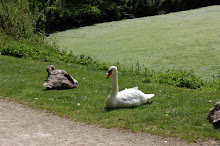I'll post commentaries here and on Mens Sana (Facebook Group).
Here's the first one.
Mere Anarchy
G. K. Chesterton, The Man Who
Was Thursday: A Nightmare, (1908), (Penguin Edition, with ‘Introduction’ by
Matthew Beaumont, 2011).
My, but this is an odd book.
When I chose it from the pile of
unread books, I thought I was picking a simple tale of derring-do, a ripping
yarn rather akin to The Riddle of the Sands (Childers, 1903) or The
Thirty-Nine Steps (Buchan, 1915), albeit hopefully leavened with
Chesterton’s characteristic wit. I knew
it was about secret anarchists and plots, bombings and detectives, but that was
about all I knew. And around this time,
there was a lot of fiction, and nonfiction concerning anarchists being written.
The Spirit of Revolt (Kropotkin,
1880), The Dynamiter (Stevenson, 1885), The Science of Revolutionary
Warfare: A Little Handbook of Instruction in the Use and Preparation of
Nitroglycerine, Gun-Cotton, Fulminating Mercury, Bombs, Fuses, Potions, Etc,
Etc (Most, 1885), The League of Twelve (Boothby, 1903), A Girl
Among the Anarchists (Olivia and Helen Rossetti, 1903) and The Secret Agent (Conrad, 1907) are all
mentioned in the critical apparatus in the book.
Nobel had patented dynamite in 1866 (first
demonstrated in Redhill) and gelignite in 1876.
In 1893, the Chamber of Deputies in Paris was bombed; in 1894 there was
an unsuccessful bomb attack on the Royal Observatory in Greenwich, and
separately the French President was assassinated; in 1897 the Spanish prime
minister was assassinated; in 1900 the King of Italy was assassinated; in 1906
there was a failed attempt to bomb the King of Spain; and in the month Chesterton’s book was
published the King of Portugal and his son were assassinated. Bombs, revolutions, assassinations and
anarchists were on everyone’s minds.
And there is a plot, a story
which revolves around all of this material, as a detective/poet attempts to
thwart an anarchist plot to bomb the Czar and the President of France, in
Paris. It is a plot concerning the fight
between order and anarchy, as conducted by a brave individual. But it is such an extreme, madcap, ridiculous
plot that you end up coming to the conclusion that it isn’t really the
point.
Partly this is because it is
written by Chesterton. As such, the book
is full of witty observations, paradoxes and inversions.
“All the same,” replied Syme
patiently, “just at present you only see the tree by the light of the
lamp. I wonder when you would ever see
the lamp by the light of the tree.” (p.8).
The paradoxes are even there in some of the chapter titles (11: ‘The Criminals Chase the Police’). And while some of the observations feel
hopelessly dated, many still seem quite fresh over a century later interesting
– such as when he speaks of the uncanny feeling one gets at a waxworks (p.39) –
an early example of the ‘Uncanny Valley’?
Chesterton is also very good on
small details and the quotidian. He
wants to describe everything, even the most mundane item. He cares about the wonderfulness of the
everyday, the banal ordinary. As when
the hero is inspired to courage by the sound of a simple, common barrel organ
in Leicester Square.
At the same time, his abiding
interest in the grotesque is ever-present.
Every one of the anarchists has odd, weird traits, unlikely facial
expressions and tics. None just look
normal or unremarkable.
So, in one sense this novel is
Chesterton’s version of Browning’s dramatic monologues (see Men and Women
(1855), Dramatis Personae (1864) and many other individual poems). And of course, he had written his excellent
book on the poet in 1903, praising his grotesqueries and his interest in the
quotidian, while arguing that these were also routes to the spiritual (I
paraphrase).
Amongst the grotesques the huge
figure of the President of the anarchists stands out. And as Chesterton himself was a large man,
one begins by assuming that this is a self-portrait. After all the President sets much of the plot
in action and is feared by all the others; an obvious author-substitute. However, by the end one realises this is
probably not the case. Or not just the
case.
Because the end is quite
unexpected. If the story is so extreme
and the characters so unlikely, that they undermine the whole notion of the
adventure-narrative, and also play against Chesterton’s fine details and
interest in the ordinary, which I would contend they do, then the conclusion of
the novel takes another yet turn to the unexpected.
It goes all mythic and
transcendent. Arguably this may have
been the only place left for Chesterton’s madcap narrative to go, but it still
comes as a surprise. Without saying too
much, it goes supernatural and religious, and there are some interesting
proto-surrealist touches.
…a vast carnival of people were dancing in motley dress. Syme seemed to see every shape in Nature imitated in some crazy costume. There was a man dressed as a windmill with enormous sails, a man dressed as an elephant, a man dressed as a balloon… one dancer dressed like an enormous hornbill, with a beak twice as big as itself…(p.152)
For Chesterton, nonsense was a
type of writing replete with spiritual significance, because it so effectively
communicates a sense of amazement at the ‘huge and undecipherable unreason’ of
life itself. (Chesterton, The Defendant, (1901), taken from Beaumont’s
‘Introduction’).
So this isn’t just an adventure story from the early twentieth century. Chesterton’s full title for the novel gives it away, in part. It has all the logic of a mad dream.
And it is a page-turner, but what
those pages turn up is just not what you might expect.




No comments:
Post a Comment